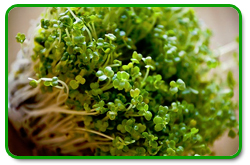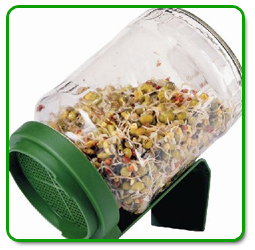 Sprouts provide fresh, easy nutrition and can be harvested within days-typically a week or less from seed to edible sprout. When growing sprouts, always choose organic seeds andstore in a cool, dark, dry setting. Tastes can vary considerably between different varieties. Small, commonly available sprouts like red clover and alfalfa are relatively sweet while more exotic sprouts from brassica family members such as radish or mustard have a spicy or stimulating taste. Nearly all sprouts will contain vitamins and enzymes, which are synthesized by the growing seedling. However as sprouts are not grown in a solid medium, they do not take up minerals and will show lower content relative to microgreens or full size-vegetables. Sprouts provide fresh, easy nutrition and can be harvested within days-typically a week or less from seed to edible sprout. When growing sprouts, always choose organic seeds andstore in a cool, dark, dry setting. Tastes can vary considerably between different varieties. Small, commonly available sprouts like red clover and alfalfa are relatively sweet while more exotic sprouts from brassica family members such as radish or mustard have a spicy or stimulating taste. Nearly all sprouts will contain vitamins and enzymes, which are synthesized by the growing seedling. However as sprouts are not grown in a solid medium, they do not take up minerals and will show lower content relative to microgreens or full size-vegetables.
Sprouting Suggestions
- Always use fresh, clean water when soaking and rinsing your sprouts, and rinse at least 3-4 times daily.
- After rinsing and soaking, thoroughly drain of excess water. Sprouts left sitting in water, or with excess moisture, can be vulnerable to rotting and must not be consumed. Be especially cautious with sprouts that have been exposed to warm, moist conditions as they are particularly susceptible to bacteria and other pathogens. Sprouts are easy to grow, but if you ever have doubts about the cleanliness or safety of sprouts, it is wise to discard that batch immediately and begin a new one.
- Sprouts should be soaked for 4 hours or longer prior to growth. Larger seeds, such as chickpeas and other large beans, require more soaking time (8-10 hours) than smaller seeds such as alfalfa or red clover.
- Always wash your sprouter between uses, and do not eat sprouts that are soggy, lifeless, or give off a foul odor. Such signs may indicate rotting sprouts, which should not be consumed and should be discarded. Better safe than sorry.
- Store growing sprouts on countertop, or other warm (approximately room temperature) environment. Exposure to moderate light amounts of light may be beneficial and help to promote faster growth.
 Choosing a Sprouter Choosing a Sprouter
There are many types of sprouters available from jars to bags to elaborate, automated containers. While it is important to keep your sprouts well hydrated, it is equally crucial that they have proper drainage. If not, your seeds may not germinate properly or the freshness of your growing sprouts will be compromised. Therefore select a sprouter that is easy to completely and quickly drain out after rinsing. Always clean your sprouter between uses.
Growing Your Sprouts
The time required to grow edible sprouts varies slightly from seed to seed, but the process generally does not.
- To start your sprouts, you will want to soak your seeds in a bowl of cool water for 4-6 hours, or overnight, making certain that seeds are submersed and not floating on top of the water. This will soften the seed coat and promote germination. After soaking, thoroughly drain off all water. It is wise to rinse seeds immediately after soaking to clean them and wash away an extraneous matter, and again drain off all excess water.
- Wait several hours, then later in that day: Rinse seeds with cool, clean water. Carefully drain off all water so seeds at bottom of sprouter are not covered with water.
- Repeat this process of rinsing with cool water and draining 3-4 times per day as your seeds mature, and even as you begin to harvest and consume them. As your sprouts grow, it is important that they receive good air circulation. Many types of sprouters, such as simple canning jar types, provide good circulation with the tilting motion necessary for complete drainage. Keep your container on your kitchen table or counter, or similar location that has dependable lighting and airflow.
- Once sprouts have reached a desirable state for consumption, they can be transferred out of sprouter and placed under refrigeration to prolong their lifespan. This is not necessary but will slow down the growth process and give you a larger window to eat your sprouts. Sprouts should not be allowed to dry out, as they can quickly lose their vitality and nutritional content.
- Clean sprouter thoroughly after use.
Within a few days, you will be able to start collecting your sprouts and using them in salads, sandwiches and as a crunchy & nutritious complement in all sorts of culinary creations. Most people find sprouts more palatable prior to photosynthesis when the plant begins to show green leaves and other signs of development, but they will remain safe for consumption. Growing your own sprouts is simple and easy, and with little experience you will have no problem finding quick success. Happy sprouting!
Below is a table with sprouting times for some of the more commonly available varieties:
Sprout |
Days to Sprout |
Taste & Qualities |
Prominent Nutrients |
|
Alfalfa |
5-7 days |
Mild, light, with a
pleasant 'crunch' |
Vitamins D & K
Slight mineral content |
|
Arugula |
3-6 days |
Spicy, peppery taste |
Vitamins A & C
Iron |
|
Broccoli |
3-6 days |
Spicy mustard taste |
Rich in antioxidant content |
|
Clover |
5-6 days |
Mild, sweet |
Vitamins A, B, C, E
Mineral content
High protein |
|
Fenugreek |
3-6 days |
Unique, pungent |
Vitamin A
Phosphorous & Iron |
|
Lentil |
2-4 days |
Mild, cruchy taste
& texture |
Vitamins A, C, E
Rich in amino acids
Some mineral content |
|
Mung |
2-4 days |
Thick, mild |
Vitamins A, B, C, E
Iron, Magnesium |
|
Mustard |
3-6 days |
Strong & spicy mustard taste |
Vitamins A, B, C
Mineral content |
|
Radish |
3-6 days |
Hot & spicy |
Vitamin C
Potassium, Amino acids |
|